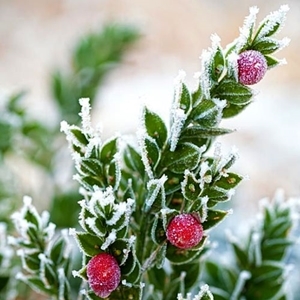Butcher’s broom
 The butcher’s broom (Ruscus aculeatus) is a very curious evergreen shrub. It’s a close relative of asparagus and lilies, steeped in anthropogenic history, and it lends a bit of colour and cheer to shady corners of the countryside in winter.
The butcher’s broom (Ruscus aculeatus) is a very curious evergreen shrub. It’s a close relative of asparagus and lilies, steeped in anthropogenic history, and it lends a bit of colour and cheer to shady corners of the countryside in winter.
It is present throughout Britain but is most abundant in woodlands and copses in southern England and Wales. It is native to Eurasia and North Africa too, and does well in the Mediterranean climate. The plant seems to favour well-drained, poor soils, and thanks to its sturdy, water-retentive design it can cope well with drought, which is probably why it is quite at home in the dry plains of southern Europe.
Butcher’s broom grows as stiff clumps of glossy, prickly foliage, which form impenetrable and sometimes expansive stands on the woodland floor. It rarely reaches more than thigh-height (earning it another name: knee holly). It might surprise you to find out that its ‘leaves’ are actually what botanists call ‘cladodes’ – flattened branches with sharp spines on the end. The true leaves are tiny and grow at the base of the cladodes. After two or three years, a proportion of the stems die and turn brown, and this desiccated foliage remains entangled in the plant for a long time, with the spines no less formidable!
Butcher’s broom is dioecious, which means it has male and female plants. Both forms grow delicate green and purple flowers in the middle of the cladodes – but only the female flowers go on to produce fruit. Starting off as a small green bead, these engorge and turn into a succulent red berry, giving the whole plant a certain festive appeal.
Because of this festive look, butcher’s broom was often picked and arranged indoors for Christmas. And as you can probably guess from its name, its sturdy foliage was used to scrub clean butcher’s blocks, long before the days of plastic bristles and disinfectant. The antibacterial oil within the plant may have improved the hygiene of a butchery and therefore led to more business (or less business dying from food poisoning!), and therefore more widespread usage.
A concoction of the root has been used in the past to treat a wide range of ailments, including gangrene, circulatory problems and tissue swelling. Apparently ancient Greeks used butcher’s broom as a laxative and diuretic, and to treat kidney stones when added to wine (of course… it wouldn’t have worked if added to water). And to top off this list of accolades, another source claims it contains anthocynins that can be used in cancer treatment.
Despite its medicinal properties, not many animals eat this plant due to its spiny defences. It has two ways of reproducing: underground rhizomes and berry dispersal via birds. It is thought the vast majority of spread is caused by the rhizomes, but deliberate planting is a factor in its range increase too, due to its popularity as a shady garden space filler. Alongside the wild original, various cultivars have emerged and escaped – as is unfortunately the story with many plants with attractive features desired by gardeners!
New shoots of butcher’s broom can apparently be eaten like its cousin asparagus, and the seeds inside the berries can be crushed to make a coffee of sorts. All in all, a seemingly useful shrub, so if you’ve got to grab and cultivate one plant during an impending apocalypse, you might do worse than this one – you could be sautéing shoots, drinking tincture of roots, and sweeping your abode in no time!
Jess Brooks
Advisory
Photo credit: Richard Bloom

GWCT Bestseller: A Natural History of the Hedgerow
Informative, practical, entertaining and richly illustrated in colour throughout, A Natural History of the Hedgerow is a book to stuff into your pocket for country walks in every season, or to savour in winter before a roaring fire
View Book >
or
Buy Now - £12.00 >
100% Secure. All Credit & Debit cards, PayPal, Apple Pay and Google Pay accepted.
